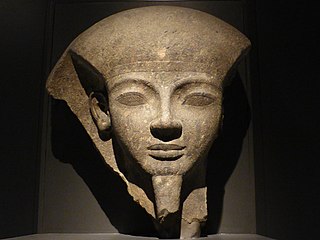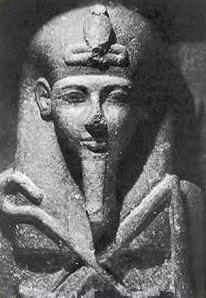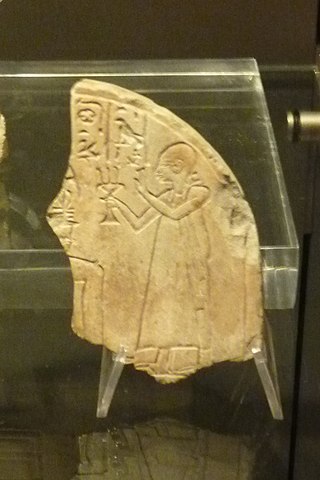
Thutmose II was the fourth Pharaoh of the Eighteenth Dynasty of Egypt. His reign is generally dated from 1493 to 1479 BC. His body was found in the Deir el-Bahri Cache above the Mortuary Temple of Hatshepsut and can be viewed today in the National Museum of Egyptian Civilization in Cairo.

Neferkare Setepenre Ramesses IX was the eighth pharaoh of the Twentieth Dynasty of Egypt. He was the third longest serving king of this Dynasty after Ramesses III and Ramesses XI. He is now believed to have assumed the throne on I Akhet day 21 based on evidence presented by Jürgen von Beckerath in a 1984 GM article. According to Papyrus Turin 1932+1939, Ramesses IX enjoyed a reign of 18 years and 4 months and died in his 19th Year in the first month of Peret between day 17 and 27. His throne name, Neferkare Setepenre, means "Beautiful Is The Soul of Re, Chosen of Re." Ramesses IX is believed to be the son of Mentuherkhepeshef, a son of Ramesses III, since Mentuherkhopshef's wife, the lady Takhat bears the prominent title of King's Mother on the walls of tomb KV10, which she usurped and reused in the late 20th Dynasty; no other 20th Dynasty king is known to have had a mother with this name. Ramesses IX was, therefore, probably a grandson of Ramesses III.

Khepermaatre Ramesses X was the ninth pharaoh of the 20th Dynasty of Ancient Egypt. His birth name was Amonhirkhepeshef. His prenomen or throne name, Khepermaatre, means "The Justice of Re Abides."

Ramesses VI Nebmaatre-Meryamun was the fifth ruler of the Twentieth Dynasty of Egypt. He reigned for about eight years in the mid-to-late 12th century BC and was a son of Ramesses III and queen Iset Ta-Hemdjert. As a prince, he was known as Ramesses Amunherkhepeshef and held the titles of royal scribe and cavalry general. He was succeeded by his son, Ramesses VII Itamun, whom he had fathered with queen Nubkhesbed.

Amenmesse was the fifth pharaoh of the Nineteenth Dynasty in Ancient Egypt, possibly the son of Merneptah and Queen Takhat. Others consider him to be one of the innumerable sons of Ramesses II. Very little is known about this pharaoh, who ruled Egypt for only three to four years. Various Egyptologists date his reign between 1202 BC–1199 BC or 1203 BC–1200 BC with others giving an accession date of 1200 BC. Amenmesse means "born of or fashioned by Amun" in Egyptian. Additionally, his nomen can be found with the epithet Heqa-waset, which means "Ruler of Thebes". His royal name was Menmire Setepenre.

Twosret, also spelled Tawosret or Tausret was the last known ruler and the final pharaoh of the Nineteenth Dynasty of Egypt.

Bay, also called Ramesse Khamenteru, was an important Asiatic official in ancient Egypt, who rose to prominence and high office under Seti II Userkheperure Setepenre and later became an influential powerbroker in the closing stages of the 19th Dynasty. He was generally identified with Irsu mentioned in the Great Harris Papyrus, although no contemporary source connects Bay with Irsu.

Akhenre Setepenre Siptah or Merenptah Siptah was the penultimate ruler of the Nineteenth Dynasty of Egypt. His father's identity is currently unknown. Both Seti II and Amenmesse have been suggested although the fact that Siptah later changed his royal name or nomen to Merneptah Siptah after his Year 2 suggests rather that his father was Merneptah. If correct, this would make Siptah and Seti II half-brothers since both of them were sons of Merneptah.
Tomb KV10, located in the Valley of the Kings near the modern-day Egyptian city of Luxor, was cut and decorated for the burial of Pharaoh Amenmesse of the Nineteenth Dynasty of Ancient Egypt. However, there is no proof that he was actually buried here. Later, the decoration was replaced with scenes for Takhat and Baketwernel—two royal women dating to the late 20th Dynasty.
Tomb KV47, located in the Valley of the Kings in Egypt, was used for the burial of Pharaoh Siptah of the Nineteenth Dynasty. It was discovered on December 18, 1905 by Edward R. Ayrton, excavating on behalf of Theodore M. Davis; Siptah's mummy had been found earlier, cached in KV35. It was the last of the Nineteenth and Twentieth Dynasty kings tombs to be uncovered in the Valley. Ayrton stopped his excavation in 1907 due to safety fears, and Harry Burton returned in 1912 to dig further. The cutting of a side passage was halted after the workmen cut into Side Chamber Ja of the tomb of Tia'a (KV32). The tomb was unfinished at the time of its use.

Takhat was an ancient Egyptian princess and queen of the 19th Dynasty, the mother of the usurper pharaoh Amenmesse.
Takhat was the mother of ancient Egyptian Pharaoh Ramesses IX of the 20th Dynasty.
Tyti was an ancient Egyptian queen of the 20th Dynasty. A wife and sister of Ramesses III and possibly the mother of Ramesses IV.
Neserkauhor was an Ancient Egyptian prince, son of pharaoh Djedkare Isesi, during the second half of Fifth Dynasty. Neserkauhor was buried in Abusir, in an area known today as "Djedkare's family cemetery".

Roma called Roy was High Priest of Amun during the Nineteenth Dynasty of Egypt, at the end of the reign of Ramesses II and continued into the reigns of Merenptah and likely Seti II. Roma served as third and second priest of Amun and finally as first prophet of Amun. He was also a count (h3ty-a), a prince (iry-pat) and a divine father pure of hands.

Hori was a Vizier of Ancient Egypt. He served during the reign of pharaohs Sethi II, Siptah, Tawosret, Setnakhte and Ramesses III.
Khaemtir was a Viceroy of Kush and Vizier of Ancient Egypt. He served during the reign of Amenmesse and Seti II.

The Twentieth Dynasty of Egypt is the third and last dynasty of the Ancient Egyptian New Kingdom period, lasting from 1189 BC to 1077 BC. The 19th and 20th Dynasties furthermore together constitute an era known as the Ramesside period. This dynasty is generally considered to be the start of the decline of Ancient Egypt.

Siese the Younger was the Superintendent of the Granary during the reign of Ramesses II and Merenptah. Siese and his family came from Asyut.
Anuketemheb was an ancient Egyptian princess and queen of the 19th or the 20th Dynasty. She is known from only one artifact, a red granite sarcophagus lid which was originally hers but was later reused for Takhat, the mother of Amenmesse and was discovered in the tomb KV10.












